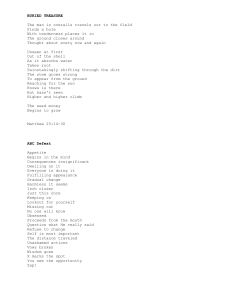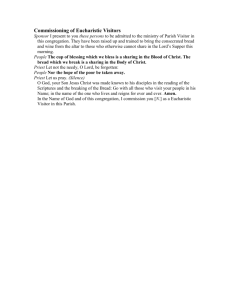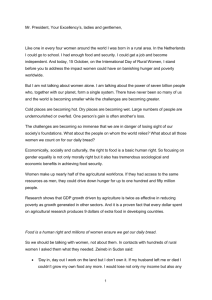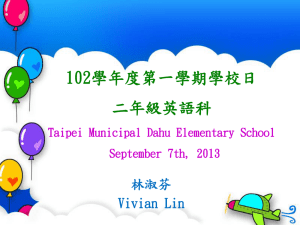Unit 5B Bread - Gunter Primary School
advertisement
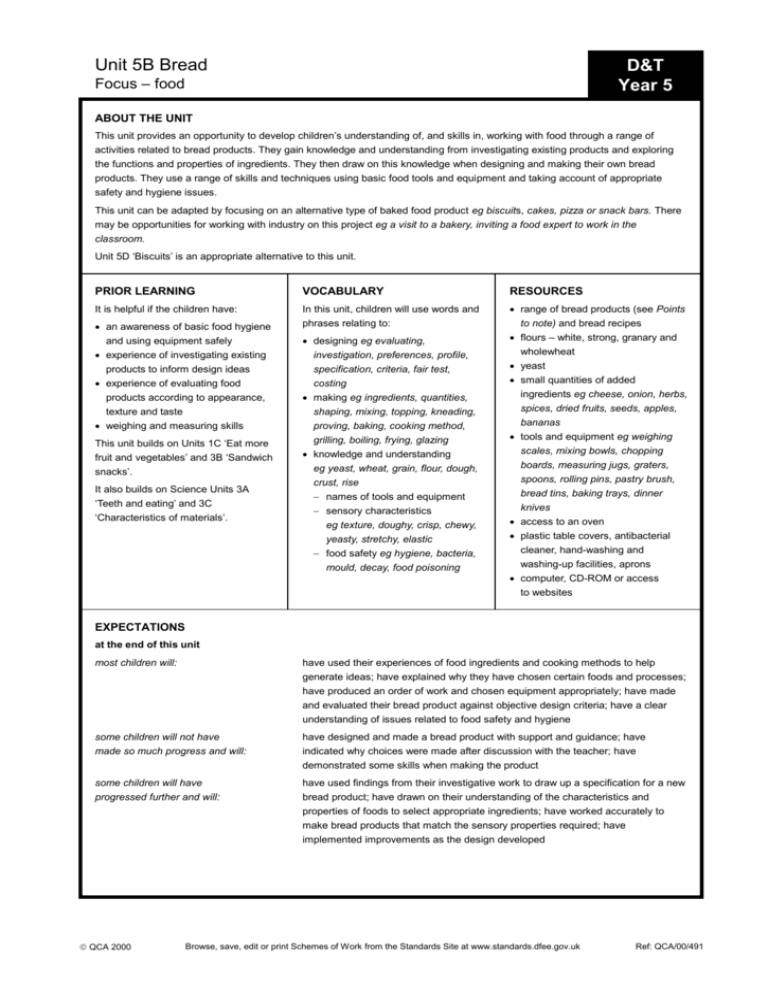
Unit 5B Bread D&T Year 5 Focus – food ABOUT THE UNIT This unit provides an opportunity to develop children’s understanding of, and skills in, working with food through a range of activities related to bread products. They gain knowledge and understanding from investigating existing products and exploring the functions and properties of ingredients. They then draw on this knowledge when designing and making their own bread products. They use a range of skills and techniques using basic food tools and equipment and taking account of appropriate safety and hygiene issues. This unit can be adapted by focusing on an alternative type of baked food product eg biscuits, cakes, pizza or snack bars. There may be opportunities for working with industry on this project eg a visit to a bakery, inviting a food expert to work in the classroom. Unit 5D ‘Biscuits’ is an appropriate alternative to this unit. PRIOR LEARNING VOCABULARY RESOURCES It is helpful if the children have: In this unit, children will use words and phrases relating to: range of bread products (see Points to note) and bread recipes flours – white, strong, granary and wholewheat yeast small quantities of added ingredients eg cheese, onion, herbs, spices, dried fruits, seeds, apples, bananas tools and equipment eg weighing scales, mixing bowls, chopping boards, measuring jugs, graters, spoons, rolling pins, pastry brush, bread tins, baking trays, dinner knives access to an oven plastic table covers, antibacterial cleaner, hand-washing and washing-up facilities, aprons computer, CD-ROM or access to websites an awareness of basic food hygiene and using equipment safely experience of investigating existing products to inform design ideas experience of evaluating food products according to appearance, texture and taste weighing and measuring skills This unit builds on Units 1C ‘Eat more fruit and vegetables’ and 3B ‘Sandwich snacks’. It also builds on Science Units 3A ‘Teeth and eating’ and 3C ‘Characteristics of materials’. designing eg evaluating, investigation, preferences, profile, specification, criteria, fair test, costing making eg ingredients, quantities, shaping, mixing, topping, kneading, proving, baking, cooking method, grilling, boiling, frying, glazing knowledge and understanding eg yeast, wheat, grain, flour, dough, crust, rise names of tools and equipment sensory characteristics eg texture, doughy, crisp, chewy, yeasty, stretchy, elastic food safety eg hygiene, bacteria, mould, decay, food poisoning EXPECTATIONS at the end of this unit most children will: have used their experiences of food ingredients and cooking methods to help generate ideas; have explained why they have chosen certain foods and processes; have produced an order of work and chosen equipment appropriately; have made and evaluated their bread product against objective design criteria; have a clear understanding of issues related to food safety and hygiene some children will not have made so much progress and will: have designed and made a bread product with support and guidance; have indicated why choices were made after discussion with the teacher; have demonstrated some skills when making the product some children will have progressed further and will: have used findings from their investigative work to draw up a specification for a new bread product; have drawn on their understanding of the characteristics and properties of foods to select appropriate ingredients; have worked accurately to make bread products that match the sensory properties required; have implemented improvements as the design developed QCA 2000 Browse, save, edit or print Schemes of Work from the Standards Site at www.standards.dfee.gov.uk Ref: QCA/00/491 Browse, save, edit or print Schemes of Work from the Standards Site at www.standards.dfee.gov.uk LEARNING OBJECTIVES Primary Schemes of Work: Design & Technology Unit 5B Bread. POSSIBLE TEACHING ACTIVITIES LEARNING OUTCOMES CHILDREN SHOULD LEARN POINTS TO NOTE CHILDREN INVESTIGATIVE, DISASSEMBLY AND EVALUATIVE ACTIVITIES (IDEAs) that there is a wide variety of bread products from a variety of cultural traditions that bread products are an important part of a balanced diet and can be eaten in different ways to investigate and evaluate bread products according to their characteristics to use an appropriate vocabulary to describe bread products to use ICT for research purposes name and identify the origin of a number of bread products talk about the contribution that bread can make to a healthy diet demonstrate through their recording sheets understanding of how different bread products can be classified use a wide sensory vocabulary to describe bread products use ICT for researching Provide a variety of breads and bread products with different characteristics from a variety of cultural traditions eg soft white, granary, wholemeal, sesame, poppy seed, chapatti, soda, pitta, flavoured – sweet or savoury. Discuss where they originate from and their general features. Encourage the children to examine and smell the breads, to name them, weigh them, talk about texture, appearance, shape and personal preferences. Taste the breads and record a star profile for each one for appearance, texture, flavour and cost; carry out discrimination tests. Talk about the nutritional value of bread and discuss how bread is used in different ways in meals eg for toast, for sandwiches, to eat with soup, to scoop up curry. Which bread products are most suitable for which purposes? For one week, survey types and amounts of bread eaten and how it is eaten eg toast. Provide access to suitable websites and CD-ROMs for research relating to different types of bread and to find out how bread is made. Ask the children to interview a person over 40 years old about what bread was available when they were young. How is it different from the bread eaten today? Why are people willing to pay a great deal more for a speciality bread than an ordinary loaf? Links to this unit Science: Units 5A ‘Keeping healthy’, 5D ‘Changing state’, 6B ‘Micro-organisms’ (short unit) Information technology: Units 3A ‘Combining text and graphics’, 5B ‘Analysing data and asking questions: using complex searches’, 5D ‘Introduction to spreadsheets’ Mathematics: Number (reduce, percentage, symbol, maximum, minimum value, accuracy, calculate, check) Literacy: Emphasise the use of words and phrases which make sequential or causal connections eg while, during, after as a prelude to writing specifications and recipes Content This unit provides an opportunity to develop knowledge of the cultural and social aspects of food, as well as developing an understanding of basic nutrition. Refer to the ‘balanced plate’ model in Unit 3B ‘Sandwich snacks’. The key message about bread is EAT LOTS. Encourage children to eat wholemeal, wholegrain, brown or high-fibre versions where possible. Try to avoid adding too much fat eg thickly spread butter. essential activities optional activities assignment stages (all are essential) QCA 2000 1 Ref: QCA/00/491 Browse, save, edit or print Schemes of Work from the Standards Site at www.standards.dfee.gov.uk LEARNING OBJECTIVES Primary Schemes of Work: Design & Technology Unit 5B Bread. POSSIBLE TEACHING ACTIVITIES LEARNING OUTCOMES CHILDREN SHOULD LEARN POINTS TO NOTE (cont.) CHILDREN FOCUSED PRACTICAL TASKS (FPTs) to compare the processes involved in making bread products – commercial and domestic to follow instructions to weigh and measure accurately (time, dry ingredients, liquids) skills in using different tools and equipment that ingredients have different characteristics that the proportion of ingredients will affect the product how to work safely and hygienically know about the processes involved in making bread products follow instructions in order to conduct fair tests demonstrate accurate, effective and appropriate use of equipment, using safe and hygienic working practices understand that the properties and quantities of ingredients will affect the final product follow safe procedures for food safety and hygiene Demonstrate to the children how to make a basic bread mixture. With the children, investigate the effects of using different ingredients and cooking methods. Bake bread using different types of flour eg rye, white, chapatti. How is flour manufactured today? Find out how grains are made into flour. Ask the children to add different ingredients eg sugar, milk, fruit or butter to a bread dough. Compare the results and discuss how each ingredient causes changes to the end product. Explain and demonstrate hygiene and safety rules. Allow the children to role play working hygienically and safely. Children could use different types of yeast (fresh or dried) or raising agent (soda). Discuss Is bread always made with yeast? What does yeast do? How much do you need to use? How much does each cost? Which end product tastes the best? Children could try different shapes. How long does each take to cook? Which is easiest to make? How evenly does it cook? Children could try different finishes eg flour, seeds, nuts, grated cheese, milk, sugar, glazes. What differences do various finishes make to the crust and appearance? How much does each cost? Children could use different cooking methods eg baking, boiling, grilling, frying. Discuss the effect of adding different quantities eg too much onion may be overwhelming and at which stage of the process they might be added eg added to dry ingredients, during shaping or as a topping. Content (cont.) Careful selection of a range of bread products will help to keep the costs down eg croissant, roll, granary stick, chapatti, fruit loaf, pitta bread, Chelsea bun, yet still show different characteristics and methods of production. The FPTs provide the opportunity for children to learn how to follow a recipe for making bread but also to consider ways of adapting basic recipes by adding or substituting some of the ingredients, using different cooking and shaping methods. If there is time during the DMA, it will be helpful for children to be able to evaluate, suggest improvements and have another attempt at making bread. The children could create their own leaflet/poster relating to food safety and hygiene. Class management The activities in this unit will be a mixture of whole class and group. Other related activities might include: collecting, representing and interrogating data of which breads children prefer and/or eating habits writing and illustrating a classbook of bread recipes researching bread products from different countries and presenting findings appropriately looking at examples of recipes and writing their own. (This links well to the literacy focus in term 2 on instructional texts.) Small groups of children could agree a specification for their product and then divide the prepared dough to make one roll each. essential activities optional activities assignment stages (all are essential) QCA 2000 2 Ref: QCA/00/491 Browse, save, edit or print Schemes of Work from the Standards Site at www.standards.dfee.gov.uk LEARNING OBJECTIVES Primary Schemes of Work: Design & Technology Unit 5B Bread. POSSIBLE TEACHING ACTIVITIES LEARNING OUTCOMES CHILDREN SHOULD LEARN POINTS TO NOTE (cont.) CHILDREN DESIGN AND MAKE ASSIGNMENT (DMA) Design and make a new bread product for a specific occasion or person to use results of investigations when developing design ideas to use a specification to clarify ideas to plan what has to be done to apply the rules for basic food hygiene and other safe practices eg hazards relating to the use of ovens to work accurately to evaluate a product against the original design specification apply what they have learnt through IDEAs/FPTs in their designing and making use investigations to select appropriate ingredients for the final product write the appropriate specification plan order of work with list of ingredients and equipment work safely, hygienically and accurately evaluate the bread product, taking into account their design specification Let the children decide in pairs or small groups what kind of bread they need to make. The class may want to make it for a specific occasion eg for a party, picnic or for a particular person. What could we do? What do we need to know? Who could we ask? What could we use? What has the bread got to be like? Provide the children with a range of suitable ingredients that could be added to their breads. Let children identify, taste and classify ingredients for texture and flavour. Ask them to draw up a simple specification identifying the type of bread product, how it might be used and the criteria for evaluation. The bread product for ... should be ...? What are the most important features? How are you going to achieve this? How will it meet the needs of the person/occasion? Ask the children to modify or adapt the basic recipe (which may be stored as text on a disk) by indicating the type of flour, extra ingredients and the stage in the process that these would be added. What would happen if ...? How much will you need? What will it look/taste like? The children make and bake the bread. Encourage them to be accurate and to work hygienically and safely. Ask the children to evaluate the bread against the specification and to indicate any improvements that could be made. Children could also compare their product against commercial products. Health and safety When carrying out a risk assessment for this activity, teachers will need to consider the materials, tools and equipment being used. In addition, the following points should be noted: parental permission should be sought before tasting sessions in order to identify any dietary and cultural requirements for consideration eg nut allergy hygiene practices should be observed eg surfaces cleaned down and wiped with antibacterial cleaner; a plastic table cover kept for food activities and used to cover wooden/old tables; aprons provided for food preparation; access to hand-washing and washing-up facilities and appropriate storage facilities for food children should learn safe practices in relation to equipment eg the oven, knives Out-of-school activities and homework Children could find out more about bread products from books, by looking at products in the shops and finding out about other people’s preferences. Visit a local bakery or store, or arrange a visit by a local baker. essential activities optional activities assignment stages (all are essential) QCA 2000 3 Ref: QCA/00/491 Browse, save, edit or print Schemes of Work from the Standards Site at www.standards.dfee.gov.uk LEARNING OBJECTIVES Primary Schemes of Work: Design & Technology Unit 5B Bread. POSSIBLE TEACHING ACTIVITIES LEARNING OUTCOMES CHILDREN SHOULD LEARN POINTS TO NOTE (cont.) CHILDREN DESIGN AND MAKE ASSIGNMENT (DMA) (cont.) Design and make a new bread product for a specific occasion or person (cont.) If there is time, the children could make the improved product. A group of children could work as a team and simulate a production line, with each one being responsible for a process such as measuring, mixing, kneading, shaping and baking. essential activities optional activities assignment stages (all are essential) QCA 2000 4 Ref: QCA/00/491


